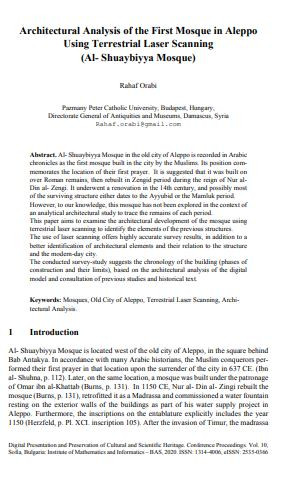
Al-Shuaybiyya Mosque in the old city of Aleppo is recorded in Arabic chronicles as the first mosque built in the city by the Muslims. Its position commemorates the location of their first prayer. It is suggested that it was built on over Roman remains, then rebuilt in Zengid period during the reign of Nur al-Din al-Zengi. It underwent a renovation in the 14th century, and possibly most of the surviving structure either dates to the Ayyubid or the Mamluk period. However, to our knowledge, this mosque has not been explored in the context of an analytical architectural study to trace the remains of each period. This paper aims to examine the architectural development of the mosque using terrestrial laser scanning to identify the elements of the previous structures. The use of laser scanning offers highly accurate survey results, in addition to a better identification of architectural elements and their relation to the structure and the modern-day city. The conducted survey-study suggests the chronology of the building (phases of construction and their limits), based on the architectural analysis of the digital model and consultation of previous studies and historical text.
I agree to the terms outlined below:
You agree to upload and assign Mosqpedia Database the rights to use the content worldwide and in perpetuity across all current and future media platforms. Mosqpedia Database may edit, copy, adapt and translate your contribution.
The content will be distributed under the Creative Commons Attribution-Deed – Attribution-NonCommercial-NoDerivatives 4.0 International – Creative Commons
All data will be stored in line with data protection regulations.